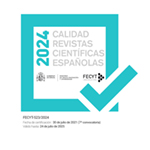Aportes desde la bioarqueología al estudio de poblaciones urbanas de la Colonia en Sudamérica (Mendoza, Argentina)
Resumen
En el presente trabajo se dan a conocer los resultados de los análisis de los restos óseos humanos recuperados mediante intervenciones arqueológicas realizadas en el año 2009 por el Centro de Investigaciones Ruinas de San Francisco en el templo San Francisco, ubicado en el Norte de Mendoza. El sector excavado corresponde a la pilastra R ubicada en la entrada del templo del siglo XVIII, abarcando tanto el exterior como el interior del mismo. Se presentan los resultados de los estudios bioantropológicos y tafonómicos del conjunto óseo correspondiente a seis individuos articulados. También se define la cronología de cada individuo de acuerdo a su posición en el espacio y contexto de entierro. Estos estudios aportan información a la caracterización de la salud y nutrición de las poblaciones históricas urbanas de la ciudad de Mendoza.Descargas
Descarga artículo
Licencia
La Revista Española de Antropología Americana, para fomentar el intercambio global del conocimiento, facilita el acceso sin restricciones a sus contenidos desde el momento de su publicación en la presente edición electrónica, y por eso es una revista de acceso abierto. Los originales publicados en esta revista son propiedad de la Universidad Complutense de Madrid y es obligatorio citar su procedencia en cualquier reproducción total o parcial. Todos los contenidos se distribuyen bajo una licencia de uso y distribución Creative Commons Reconocimiento 4.0 (CC BY 4.0). Esta circunstancia ha de hacerse constar expresamente de esta forma cuando sea necesario. Puede consultar la versión informativa y el texto legal de la licencia.









